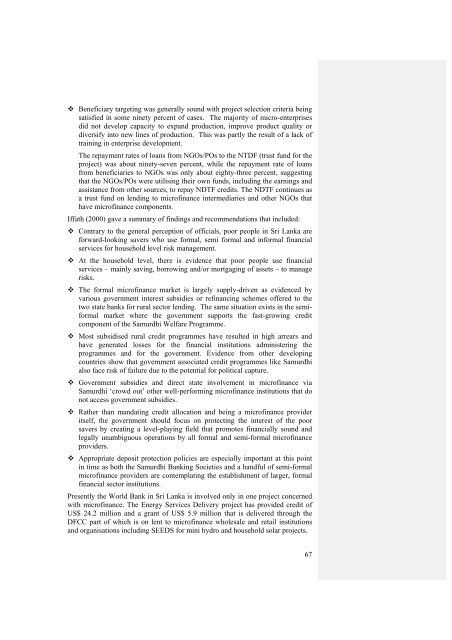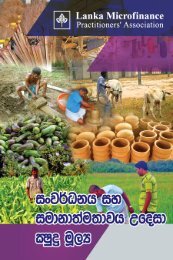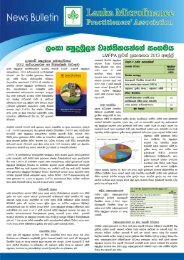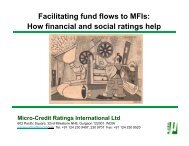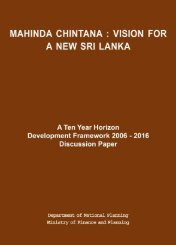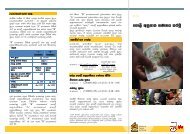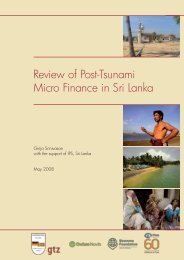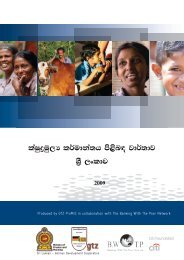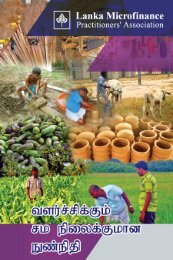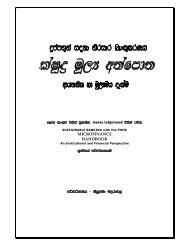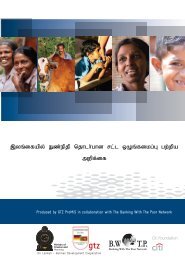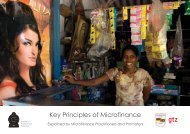National Microfinance Study of Sri Lanka: Survey of Practices and ...
National Microfinance Study of Sri Lanka: Survey of Practices and ...
National Microfinance Study of Sri Lanka: Survey of Practices and ...
You also want an ePaper? Increase the reach of your titles
YUMPU automatically turns print PDFs into web optimized ePapers that Google loves.
Beneficiary targeting was generally sound with project selection criteria being<br />
satisfied in some ninety percent <strong>of</strong> cases. The majority <strong>of</strong> micro-enterprises<br />
did not develop capacity to exp<strong>and</strong> production, improve product quality or<br />
diversify into new lines <strong>of</strong> production. This was partly the result <strong>of</strong> a lack <strong>of</strong><br />
training in enterprise development.<br />
The repayment rates <strong>of</strong> loans from NGOs/POs to the NTDF (trust fund for the<br />
project) was about ninety-seven percent, while the repayment rate <strong>of</strong> loans<br />
from beneficiaries to NGOs was only about eighty-three percent, suggesting<br />
that the NGOs/POs were utilising their own funds, including the earnings <strong>and</strong><br />
assistance from other sources, to repay NDTF credits. The NDTF continues as<br />
a trust fund on lending to micr<strong>of</strong>inance intermediaries <strong>and</strong> other NGOs that<br />
have micr<strong>of</strong>inance components.<br />
Iffath (2000) gave a summary <strong>of</strong> findings <strong>and</strong> recommendations that included:<br />
Contrary to the general perception <strong>of</strong> <strong>of</strong>ficials, poor people in <strong>Sri</strong> <strong>Lanka</strong> are<br />
forward-looking savers who use formal, semi formal <strong>and</strong> informal financial<br />
services for household level risk management.<br />
At the household level, there is evidence that poor people use financial<br />
services – mainly saving, borrowing <strong>and</strong>/or mortgaging <strong>of</strong> assets – to manage<br />
risks.<br />
The formal micr<strong>of</strong>inance market is largely supply-driven as evidenced by<br />
various government interest subsidies or refinancing schemes <strong>of</strong>fered to the<br />
two state banks for rural sector lending. The same situation exists in the semiformal<br />
market where the government supports the fast-growing credit<br />
component <strong>of</strong> the Samurdhi Welfare Programme.<br />
Most subsidised rural credit programmes have resulted in high arrears <strong>and</strong><br />
have generated losses for the financial institutions administering the<br />
programmes <strong>and</strong> for the government. Evidence from other developing<br />
countries show that government associated credit programmes like Samurdhi<br />
also face risk <strong>of</strong> failure due to the potential for political capture.<br />
Government subsidies <strong>and</strong> direct state involvement in micr<strong>of</strong>inance via<br />
Samurdhi ‘crowd out’ other well-performing micr<strong>of</strong>inance institutions that do<br />
not access government subsidies.<br />
Rather than m<strong>and</strong>ating credit allocation <strong>and</strong> being a micr<strong>of</strong>inance provider<br />
itself, the government should focus on protecting the interest <strong>of</strong> the poor<br />
savers by creating a level-playing field that promotes financially sound <strong>and</strong><br />
legally unambiguous operations by all formal <strong>and</strong> semi-formal micr<strong>of</strong>inance<br />
providers.<br />
Appropriate deposit protection policies are especially important at this point<br />
in time as both the Samurdhi Banking Societies <strong>and</strong> a h<strong>and</strong>ful <strong>of</strong> semi-formal<br />
micr<strong>of</strong>inance providers are contemplating the establishment <strong>of</strong> larger, formal<br />
financial sector institutions.<br />
Presently the World Bank in <strong>Sri</strong> <strong>Lanka</strong> is involved only in one project concerned<br />
with micr<strong>of</strong>inance. The Energy Services Delivery project has provided credit <strong>of</strong><br />
US$ 24.2 million <strong>and</strong> a grant <strong>of</strong> US$ 5.9 million that is delivered through the<br />
DFCC part <strong>of</strong> which is on lent to micr<strong>of</strong>inance wholesale <strong>and</strong> retail institutions<br />
<strong>and</strong> organisations including SEEDS for mini hydro <strong>and</strong> household solar projects.<br />
67


